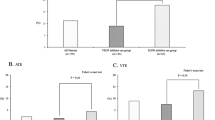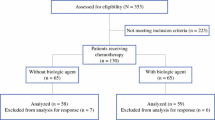Abstract
Targeted therapies in combination with traditional cytotoxic chemotherapy have revolutionized the treatment of many gastrointestinal malignancies. Although well tolerated in general, they are also associated with unique toxicities and perioperative issues. Anti-vascular endothelial growth factor (VEGF) therapy is the best studied and most widely used targeted strategy in the treatment of GI maligancies. Bevacizumab (BV) is the most widely used agent and is unique in its long half-life. Wound complications as well as gastrointestinal perforations appear to be higher in patients who undergo surgical procedures while receiving BV, although it remains unclear as to when to stop BV prior to surgery. The use of BV prior to hepatic resection, however, is safe and does not lead to an increase in morbidity or mortality. Other approved VEGF agents have been less studied, but do not appear to lead to increased complications. Other biologic agents including those targeting the epidermal growth factor receptor (EGFR) pathway and others also do not appear to be associated with an increase in perioperative complications.
Similar content being viewed by others
References
Gordon MS et al (2001) Phase I safety and pharmacokinetic study of recombinant human anti-vascular endothelial growth factor in patients with advanced cancer. J Clin Oncol 19(3):843–850
Ho QT, Kuo CJ (2007) Vascular endothelial growth factor: biology and therapeutic applications. Int J Biochem Cell Biol 39(7–8):1349–1357
Bevacizumab Package Insert, Genentech Biooncology Inc
Scappaticci FA et al (2005) Surgical wound healing complications in metastatic colorectal cancer patients treated with bevacizumab. J Surg Oncol 91(3):173–180
Ellis LM, Curley SA, Grothey A (2005) Surgical resection after downsizing of colorectal liver metastasis in the era of bevacizumab. J Clin Oncol 23(22):4853–4855
D’Angelica M et al (2007) Lack of evidence for increased operative morbidity after hepatectomy with perioperative use of bevacizumab: a matched case–control study. Ann Surg Oncol 14(2):759–765
Kesmodel SB, Ellis LM, Lin E, Chang GJ, Abdalla EK, Kopetz S, Vauthey J, Rodriguez-Bigas AM, Curley SA, Feig BW (2007) Complication rates following hepatic surgery in patients receiving neoadjuvant bevacizumab (BV) for colorectal cancer (CRC) liver metastases. 2007 Gastrointestinal Cancers Symposium
Reddy SK et al (2008) Addition of bevacizumab to irinotecan- and oxaliplatin-based preoperative chemotherapy regimens does not increase morbidity after resection of colorectal liver metastases. J Am Coll Surg 206(1):96–106
Hurwitz H et al (2004) Bevacizumab plus irinotecan, fluorouracil, and leucovorin for metastatic colorectal cancer. N Engl J Med 350(23):2335–2342
Giantonio BJ et al (2007) Bevacizumab in combination with oxaliplatin, fluorouracil, and leucovorin (FOLFOX4) for previously treated metastatic colorectal cancer: results from the Eastern Cooperative Oncology Group Study E3200. J Clin Oncol 25(12):1539–1544
Saif MW, Elfiky A, Salem RR (2007) Gastrointestinal perforation due to bevacizumab in colorectal cancer. Ann Surg Oncol 14(6):1860–1869
Badgwell BD et al (2007) Management of bevacizumab-associated bowel perforation: a case series and review of the literature. Ann Oncol. DOI 10.1093/annonc/mdm508
Kretzschmar A, Cunningham D, Berry S (2006) Incidence of gastrointestinal perforations and bleeding in patients starting bevacizumab treatment in first-line mCRC without primary tumor resection: preliminary results from the First BEATrial. 2006 American Society of Clinical Oncology Gastrointestinal Cancer Symposium, Abstract 248
Sugrue M, Kozloff M, Hainsworth J (2006) Risk factors for gastrointestinal perforations in patients with metastatic colorectal cancer receiving bevacizumab plus chemotherapy. 2006 American Society of Clinical Oncology Annual Meeting, Abstract 3535
Burger RA (2007) Experience with bevacizumab in the management of epithelial ovarian cancer. J Clin Oncol 25(20):2902–2908
Buchs NC et al (2008) Incidence, consequences, and risk factors for anastomotic dehiscence after colorectal surgery: a prospective monocentric study. Int J Colorectal Dis 23(3):265–270
Kabbinavar FF et al (2005) Addition of bevacizumab to bolus fluorouracil and leucovorin in first-line metastatic colorectal cancer: results of a randomized phase II trial. J Clin Oncol 23(16):3697–3705
Benoist S et al (2005) Treatment strategy for patients with colorectal cancer and synchronous irresectable liver metastases. Br J Surg 92(9):1155–1160
Muratore A et al (2007) Asymptomatic colorectal cancer with un-resectable liver metastases: immediate colorectal resection or up-front systemic chemotherapy? Ann Surg Oncol 14(2):766–770
Scoggins CR et al (1999) Nonoperative management of primary colorectal cancer in patients with stage IV disease. Ann Surg Oncol 6(7):651–657
Assy N et al (1999) Effect of vascular endothelial growth factor on hepatic regenerative activity following partial hepatectomy in rats. J Hepatol 30(5):911–915
Furnus CC et al (2003) Chronobiology of the proliferative events related to angiogenesis in mice liver regeneration after partial hepatectomy. Cell Biol Int 27(4):383–386
Kraizer Y et al (2001) Vascular endothelial growth factor and angiopoietin in liver regeneration. Biochem Biophys Res Commun 287(1):209–215
Aloia T et al (2006) Liver histology and surgical outcomes after preoperative chemotherapy with fluorouracil plus oxaliplatin in colorectal cancer liver metastases. J Clin Oncol 24(31):4983–4990
Parikh AA et al (2003) Perioperative complications in patients undergoing major liver resection with or without neoadjuvant chemotherapy. J Gastrointest Surg 7(8):1082–1088
Vauthey JN et al (2006) Chemotherapy regimen predicts steatohepatitis and an increase in 90-day mortality after surgery for hepatic colorectal metastases. J Clin Oncol 24(13):2065–2072
Gruenberger T, Tamandi D, Puhalla H, Scheithauer W, Zielinski C, Gruenberger B (2007) Bevacizumab plus XELOX as neoadjuvant therapy for patients with potentially curable metastatic colorectal cancer. J Clin Oncol 25(18S) (2007 ASCO Annual Meeting Proceedings Part I):4064
Ribero D et al (2007) Bevacizumab improves pathologic response and protects against hepatic injury in patients treated with oxaliplatin-based chemotherapy for colorectal liver metastases. Cancer 110(12):2761–2767
Clark JW et al (2005) Safety and pharmacokinetics of the dual action Raf kinase and vascular endothelial growth factor receptor inhibitor, BAY 43-9006, in patients with advanced, refractory solid tumors. Clin Cancer Res 11(15):5472–5480
Moore M et al (2005) Phase I study to determine the safety and pharmacokinetics of the novel Raf kinase and VEGFR inhibitor BAY 43-9006, administered for 28 days on/7 days off in patients with advanced, refractory solid tumors. Ann Oncol 16(10):1688–1694
Abou-Alfa GK et al (2006) Phase II study of sorafenib in patients with advanced hepatocellular carcinoma. J Clin Oncol 24(26):4293–4300
Eng FC et al (2007) Sorafenib and surgical complications: a case report of adverse reaction to sorafenib during treatment for renal cell carcinoma. Eur J Surg Oncol DOI 10.1016/j.ejso.2007.09.009
Sunitinib Package Insert; Pfizer Oncology
Normanno N et al (2006) Epidermal growth factor receptor (EGFR) signaling in cancer. Gene 366(1):2–16
Mendelsohn J, Baselga J (2006) Epidermal growth factor receptor targeting in cancer. Semin Oncol 33(4):369–385
Erbitux (Cetuximab) Package Insert; ImClone Systems Inc./Bristol-Myers Squibb Co.
Cunningham D et al (2004) Cetuximab monotherapy and cetuximab plus irinotecan in irinotecan-refractory metastatic colorectal cancer. N Engl J Med 351(4):337–345
Van Cutsem E, Nowacki M, Lang I, Cascinu S, Shchepotin I, Maurel J, Rougier P, Cunningham D, Nippgen J, Köhne C (2007) Randomized phase III study of irinotecan and 5-FU/FA with or without cetuximab in the first-line treatment of patients with metastatic colorectal cancer (mCRC): The CRYSTAL trial. J Clin Oncol 25(18S) (2007 ASCO Annual Meeting Proceedings Part I):4000
Venook A et al (2006) Phase III study of irinotecan/5FU/LV (FOLFIRI) or oxaliplatin/5FU/LV (FOLFOX) ± cetuximab for patients (pts) with untreated metastatic adenocarcinoma of the colon or rectum (MCRC): CALGB 80203 preliminary results. J Clin Oncol 24(18S) (2006 ASCO Annual Meeting Proceedings Part I):3509
Moyer JD et al (1997) Induction of apoptosis and cell cycle arrest by CP-358,774, an inhibitor of epidermal growth factor receptor tyrosine kinase. Cancer Res 57(21):4838–4848
Tarceva Package Insert; Genentech Biooncology Inc.
Panitumumab Package Insert; Amgen Incorporated
Imatinib mesylate package insert; Novartis Pharmaceuticals
Samelis GF, Ekmektzoglou KA, Zografos GC (2007) Gastrointestinal stromal tumours: clinical overview, surgery and recent advances in imatinib mesylate therapy. Eur J Surg Oncol 33(8):942–950
Andtbacka RH et al (2007) Surgical resection of gastrointestinal stromal tumors after treatment with imatinib. Ann Surg Oncol 14(1):14–24
Hasegawa J et al (2007) Surgical interventions for focal progression of advanced gastrointestinal stromal tumors during imatinib therapy. Int J Clin Oncol 12(3):212–217
Conflict of interest statement
No funds were received in support of this study. As a consultant, an author has received benefits from a commercial party indirectly related to the subject of this manuscript.
Author information
Authors and Affiliations
Corresponding author
Rights and permissions
About this article
Cite this article
Parikh, A.A., Ellis, L.M. Targeted therapies and surgical issues in gastrointestinal cancers. Targ Oncol 3, 119–125 (2008). https://doi.org/10.1007/s11523-008-0075-8
Received:
Accepted:
Published:
Issue Date:
DOI: https://doi.org/10.1007/s11523-008-0075-8




